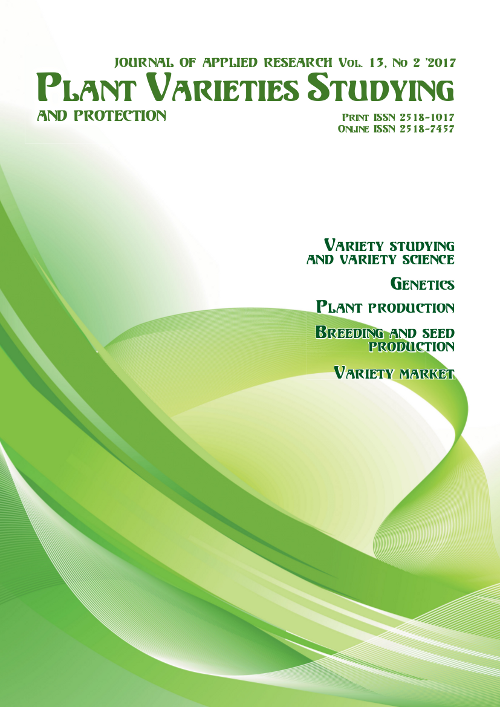Factor model of formation of seed and green mass productivity in white lupine plants
DOI:
https://doi.org/10.21498/2518-1017.13.2.2017.105411Keywords:
Lupinus albus, breeding, factor analysis, seed productivity, green mass productivityAbstract
Purpose. To study peculiarities of forming yield of seeds and green mass in white lupine. To identify the system of relationships between some elements of productivity and each factor share in the total variance of productive capacity for developing breeding programs to create varieties for different uses
Methods. Field investigation, laboratory tests, statistical analysis.
Results. After processing initial data that concerned parameters of structural elements of seed and green mass yield among multiplicity characteristics of studied plants, new key factors were identified which were characterized by a number of basic traits. In terms of seed productivity, five key factors were defined that cause over 86% of the total variability. The first factor described the productivity of laterals, the second one – the productivity of the central raceme, the third one – redistribution of assimilates between vegetative and reproductive organs, the fourth one – microredistribution of assimilates in beans; the fifth one – the ability to form productive beans. Due to the analysis of the structure of green mass productivity traits, four key factors were defined that described over 85% of the total variability: the first factor – the general growth and development; the second one – the productivity of laterals; the third one – feeding value; the fourth one – the productivity of central raceme. Factor model allowed to identify basic traits and share of each system associated with a particular factor in the formation of the complex trait of the general plant productivity of white lupine.
Conclusions. The factor model of the white lupine seed productivity formation included five key factors. The process of formation of vegetative productivity is characterized by four key factors. The variety factor model can be used for parental forms selection and assessment of new hybrid material.
Downloads
References
Sokal, R. R., & Rohlf, F. J. (1995). Biometry. Principles and practice of statistics in biological research. (3rd ed.). New York, USA: W. H. Freeman & Co.
Zhuchenko, A. A. (1980). Ekologicheskaya genetika kul’turnykh rasteniy (adaptatsiya, rekombinogenez, agrobiotsenoz) [Ecological genetics of cultivated plants (adaptation, recombinogenesis, agrobiocenosis)]. Kishinev: Shtiintsa. [in Russian]
Iberla, K. (1980). Faktornyy analiz [Factor Analysis]. (V. M. Ivanova, trans.). Moscow: Statistika. [in Russian]
Kharman, G. (1972). Sovremennyy faktornyy analiz [Modern Factor Analysis]. Moscow: Statistika. [in Russian]
Opria, A. T. (2005). Statystyka [Statistics]. Kyiv: Tsentr navchalnoi literatury. [in Ukrainian]
Syukov, V. V., Shevchenko, S. N., Madyakin, E. V., Gulaeva, N. V. & Bulgakova, A. A. (2015). Creation of Wheat Varieties system in the Context of Agro-Ecological Zoning of Samara Region. Izvestiya Samarskogo nauchnogo tsentra Rossiyskoy akademii nauk [Proceedings of the Samara Scientific Center of the Russian Academy of Sciences], 17(4), 467–472. [in Russian]
Kolomatska, V. P. (2012). Factor structure of ecological plasticity of sunflower hybrids under conditions of the Forest-Steppe zone of Ukraine. Selektsia I Nasinnitstvo [Plant Breeding and Seed Production], 101, 75–83. [in Ukrainian]
Misnikova, N. V., & Kornev, A. P. (2012). Using factor analysis for the elements of yellow lupine plants’ productivity. Kormoproizvodstvo [Forage Production], 5, 38–39. (in Russian).
Kobyzieva, L. N., Bezuhla, O. M., Sylenko, S. I. Kolotylov, V. V., Sokol, T. V., Dokukina, K. I., … Vus, N. O. (2016). Metodychni rekomendatsii z vyvchennia henetychnykh resursiv zernobobovykh kultur [Methodical recommendations on studying genetic resources of leguminous crops]. Kharkiv: N.p. [in Ukrainian]
Stepanova, S., Nazarova, N., Korneychuk, V., Leman, Kh., & Mikolaychik, Ya. (1985). Mezhdunarodnyy klassifikator SEV roda Lupinus L. [CMEA international classifier of Lupinus L. genus]. Leningrad: VIR. [in Russian]
Berk, A., Bramm, A., Böhm, H., Aulrich, K., & Rühl, G. (2008). The nutritive value of lupins in sole cropping systems and mixed intercropping with spring cereal for grain production. J. A. Palta, J. D. Berger (Eds), Lupins for health and wealth : 12th Int. Lupin Conf. (pp. 66–70). 14–18 Sept., 2008, Fremantle, Western Australia. Canterbury: International Lupin Association.
Annicchiarico, P., Harzic, N., & Carroni, A. M. (2010). Adaptation, diversity and exploitation of global white lupin (Lupinus albus L.) landrace genetic resources. Field Crops Res., 119, 114–124.
Downloads
Published
How to Cite
Issue
Section
License
Copyright (c) 2017 Т. О. Байдюк, Т. М. Левченко

This work is licensed under a Creative Commons Attribution-ShareAlike 4.0 International License.
Our journal abides by the CREATIVE COMMONS copyright rights and permissions for open access journals.
Authors, who are published in this journal, agree to the following conditions:
1. The authors reserve the right to authorship of the work and pass the first publication right of this work to the journal under the terms of a Creative Commons Attribution License, which allows others to freely distribute the published research with the obligatory reference to the authors of the original work and the first publication of the work in this journal.
2. The authors have the right to conclude separate supplement agreements that relate to non-exclusive work distribution in the form in which it has been published by the journal (for example, to upload the work to the online storage of the journal or publish it as part of a monograph), provided that the reference to the first publication of the work in this journal is included.


























 Ukrainian Institute for Plant Varieties Examination
Ukrainian Institute for Plant Varieties Examination  Селекційно-генетичний інститут
Селекційно-генетичний інститут Institute of Plant Physiology and Genetics of the National Academy of Sciences of Ukraine
Institute of Plant Physiology and Genetics of the National Academy of Sciences of Ukraine
 The National Academy of Agrarian Sciences of Ukraine
The National Academy of Agrarian Sciences of Ukraine